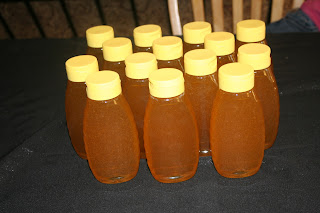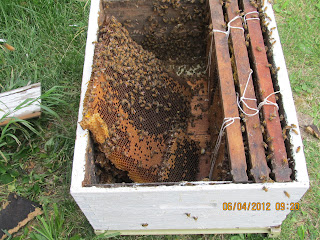So the next spring, Jerry got package #2 of bees. Again, they did okay during the warm months and died by the next spring. He was baffled. So last year, 2012 he got one more package of bees. This is package #3. An average package of bees costs about $100 so we're up to $300 to get some honey. So the honey is getting pretty pricey at this point. These bees were doing great. They put on a lot of honey even in the big drought. They were alive and kicking as late as Mid December. Jerry was thinking, "I've got it! I have bees that will live!" What do you know. Dead. No more bees are in this hive as of March. Interesting.
So he made me an offer, come get the honey out for me, I'll give you my hive. He at least wanted to have some of this $300 honey. He didn't want it anymore bees! Free hive? I'm all over that option. So I went for a road trip this morning to Jerry's house. I met him and his lovely wife. Really good people. They had a nice set up. Nice sized pond, fruit trees, cute little chicken hutches, some wild geese, pastures and woods nearby, the works. So why would he lose bees three years in a row? It didn't really make sense.
I'm no bee expert. If you've read this blog, you know this to be true. But I am a quick learner and I am intrigued as to what makes bees prosper and what makes them go kaput. I opened the top brood box, it was 100% honey. No brood, all honey. So the bees never got "Up" there to eat the winter food stores. They did not starve. I had a hive starve on me my first year, that looks like a center of bees all together with one bee per cell, Butt side out. There were no bees in this hive. Interesting.
Then I checked the bottom box. Alas, there was something strange. Here's a picture. I saw these white small round things. Round. Like eggs, but not bee eggs. In my mind I'm thinking this must be some sort of infestation that was killing off Jerry's bees. Had to be! Then again....I had never seen this in my bees, so I thought I'd drop by Paul's house on my way home.
 |
| What the Heck are those things? |
Paul had just pulled into his driveway when I arrived. He's always up for a good bee adventure too so he came right over to the van and we got to looking. He was baffled as well. Paul. My bee mentor who had seen it all was also not sure what was going on here. I asked him if these white things were some eggs of some bug that would have killed off the bees or something that could have moved in after. He did not know. "Do NOT put these in your hive yard until you know it's safe."
Now visualize this. We're standing in the middle of the street in Ursa Il. We normally do things like pull out frames and hold them up. But for someone driving by, it may look weird. To make matters worse, we decide to sniff the frames to see if they smell. We don't know what this is, and we even thought it could be frozen over foul brood...we have no idea. So the best thing to do? Sniff it in the middle of the street.
Well, only one thing left to do when Paul doesn't know and I can't put unsafe frames in the bee yard. I had to call in the top Bee man. Time to call Bernie. He just so happened to be up a Dadant's in Hamilton buying bee equipment when I called so we set up an appointment to meet at his house at 1pm.
When I got to Bernie's we got right at the investigation. He chuckled and said. "Oh that's just sugar." Huh? sugar? I know what sugar looks like and I know what sugar water looks like inside of bee cells. How could this be? Well, it more complicated than that.
This hive had been very well fed. Jerry had fed the hive as late as December when he last checked on his last attempt at beekeeping. The bees wanting all the sugar for winter put it in the cells and it sat there. But why would they not go ahead and use the sugar?
Here's the interesting answer. Bernie showed me some things about determining how a hive died out. He said, "Were the bee butts out or in?" I wasn't sure. Oh here's a cell, butts are in. As a matter fact the bees didn't fully emerge out of the brood. That was because there were no nurse bees to help them out. So I had dead bees sitting inside cells, and some died not even breaking the caps.
 |
| Sporadic brood pattern, and bees still inside cells. |
 |
| Head of bee is facing out while it's still trapped in cell. |
Because the bees had plenty of honey and sugar to eat on, they were able to keep working, hence the honey stores, but were not able to keep feeding and tending larve and capped brood. The hive died out slowly over a period of time. So when Jerry saw bees in December, they were most likely close to dying out, and just couldn't keep up.
So the "Infestation" was sugar. And the bees died of mites.
 |
| Tons of Sugar cells. Hundreds filled on each frame. |

 My plans now are to extract some honey for Jerry and see if I can get some successful bees living in his hive It's at my house. I'll try to do a split or put in a swarm this spring. If we can get some good bees living in there, I'll see if Jerry is truly finished with beekeeping on wants to give it another shot. I'll consider this hive "On loan" for now.
My plans now are to extract some honey for Jerry and see if I can get some successful bees living in his hive It's at my house. I'll try to do a split or put in a swarm this spring. If we can get some good bees living in there, I'll see if Jerry is truly finished with beekeeping on wants to give it another shot. I'll consider this hive "On loan" for now. I took several pictures because it looked so odd. Maybe this will help some other members of our bee club see what to look for in their hive inspections.
 |
| The capped honey in the upper box was in great shape. |
 |
| The sieve is full. I'll just wait for it to filter by gravity and bottle it up for Jerry. |
All in all, it was a fun day. Looks like Jerry's getting some good honey. The kids enjoyed this after school activity. The initial taste test is positive :)











































